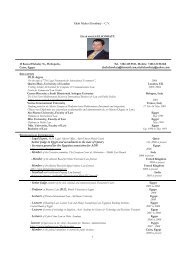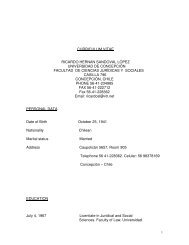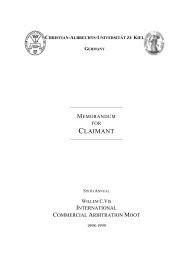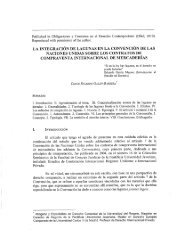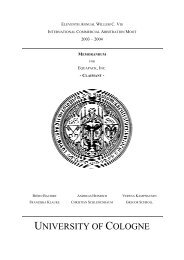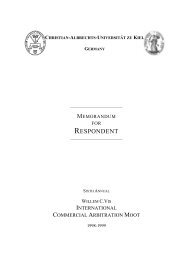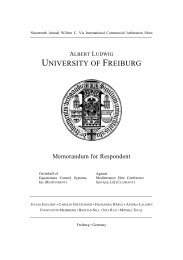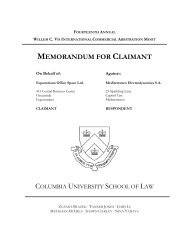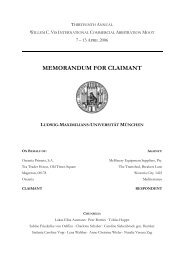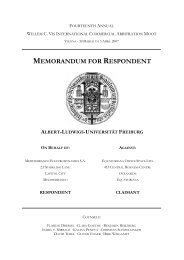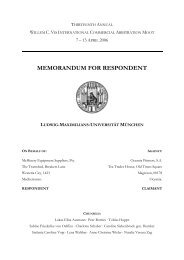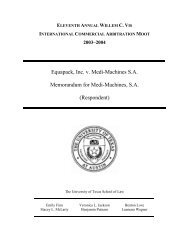MEMORANDUM FOR RESPONDENT - Pace University
MEMORANDUM FOR RESPONDENT - Pace University
MEMORANDUM FOR RESPONDENT - Pace University
You also want an ePaper? Increase the reach of your titles
YUMPU automatically turns print PDFs into web optimized ePapers that Google loves.
QUEEN’S UNIVERSITY FACULTY OF LAW<br />
within a reasonable time loses its right to all remedies relating to the non-conformity [Honnold<br />
259; Schwenzer in Schlectriem 1998 319]. Even if the Squid did not conform to the Contract,<br />
Claimant failed to notify Respondent within a reasonable time and thus forfeited its right to rely<br />
on any alleged non-conformity [I]. In addition, Respondent was unaware of facts related to the<br />
non-conformity at the time of delivery and, therefore, is not prevented by art. 40 CISG from<br />
relying on art. 39 [II].<br />
I. CLAIMANT FAILED TO PROVIDE REASONABLE NOTICE OF THE NON-CON<strong>FOR</strong>MITY IN<br />
ACCORDANCE WITH ARTS. 38 AND 39 CISG.<br />
85. Claimant notified Respondent of the alleged non-conformity on 16 August 2008 [Cl. Ex. 8; Cl.<br />
Ex. 9], after the expiry of the notice period under the CISG. The time when a buyer “ought to<br />
have discovered” a lack of conformity is determined by art. 38(1) CISG. This provision requires<br />
a buyer to reasonably examine the goods “within as short a period as is practicable” [art. 38(1)<br />
CISG]. Here, Claimant failed to perform a reasonable examination within as short a period as is<br />
practicable after taking delivery and, accordingly, failed to discover the alleged non-conformity<br />
when it ought to have done so [A]. By notifying Respondent on 16 August 2008, 45 days after it<br />
ought to have discovered the non-conformity, it failed to provide notice in accordance with art.<br />
39(1) CISG [B]. Even if Claimant gave notice of the non-conformity on 29 July 2008, this was<br />
still not within a reasonable time [C].<br />
A. A reasonable examination of the goods, conducted on or around 1 July 2008,<br />
would have discovered the alleged non-conformity.<br />
86. Claimant examined the goods shortly after taking delivery on 1 July 2008. However, this<br />
examination unreasonably failed to discover the non-conformity. The reasonableness of a<br />
buyer’s examination of goods is determined according to the circumstances [Schwenzer in<br />
Schlechtriem/Schwenzer 2010 612; Bianca in Bianca/Bonell 298]. It need not be a “complex<br />
technological analysis” [Bianca in Bianca/Bonell 297], but must be “thorough and professional”<br />
[OGH Aug 1999], according to prevailing industry standards.<br />
87. Respondent packed the Squid into approximately 20,000 cartons and labelled the cartons by<br />
catch season [Cl. Ex. 4; Clar. 32]. Respondent organized the cartons into pallets and placed the<br />
pallets into 12 shipping containers [Cl. Ex. 10 9]. When the Squid arrived, Claimant opened<br />
only two of the 12 containers. From those, Claimant selected just 20 cartons for weighing—all of<br />
which were labelled “illex danubecus 2007” [Cl. Ex. 10 10; Clar. 32]. Of these 20, Claimant<br />
defrosted only five [Cl. Ex. 10 9-10]. This level of scrutiny was unreasonable in the<br />
circumstances. Had Claimant reasonably examined the Squid, it would have easily identified the<br />
26



